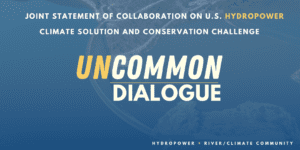
NHA BLOG: A New Uncommon Collaboration on U.S. Hydropower
By Malcolm Woolf, NHA President and CEO
It’s not every day that the hydropower industry joins forces with American Rivers, the World Wildlife Fund, and other environmental and river organizations. Yet the need to address climate change motivated these our respective organizations to find new opportunities for collaboration. I’m pleased to announce the resulting “Joint Statement of Collaboration on U.S. Hydropower: Climate Solution and Conservation Challenge.”
The Joint Statement is an effort to advance the renewable energy and storage benefits of hydropower and the environmental and economic benefits of healthy rivers. After a two-and-a-half year long discussion, facilitated under Stanford University’s Uncommon Dialogue process, the parties have agreed to work together to address a range of challenges, including licensing / relicensing, dam safety, and valuing hydropower’s grid services. Above all, the Joint Statement reflects the parties desire to start a new chapter in the relationship between the hydropower industry and the river and environmental communities.
With more than 90,000 existing U.S. dams, of which less than 2,500 have power houses, we collectively agreed that this basic fact created the opportunity to:
- Rehabilitate powered and non-powered dams that need repairs,
- Retrofit (e.g., upgrade) powered dams by adding generation at non-powered dams, developing pumped storage projects, and enhancing dam and reservoir operations, and
- Remove dams that no longer provided benefits to society, have safety issues that cannot be cost-effectively mitigated, or have adverse environmental impacts that cannot be effectively addressed.
To be sure, this is the start of the process and much work remains if we are to achieve meaningful collaboration. Broadly speaking, the parties have agreed to work together in seven areas, specifically:
- Accelerate Development of Hydropower Technologies and Practices to Improve Generation Efficiency, Environmental Performance, and Solar and Wind Integration
- Advocate for Improved U.S. Dam Safety
- Increase Basin-Scale Decision-making and Access to River-Related Data
- Improve the Measurement, Valuation of and Compensation for Hydropower Flexibility and Reliability Services and Support for Enhanced Environmental Performance
- Advance Effective River Restoration through Improved Off-Site Mitigation Strategies
- Improve Federal Hydropower Licensing, Relicensing, and License Surrender Processes
- Advocate for Increased Funding for U.S. Dam Rehabilitation, Retrofits and Removals
In the coming weeks and months, we will work together to develop a plan to guide our joint efforts.
Hydropower is essential to deep decarbonization of our nation’s electric grid and any climate solution. Our nation’s electricity grid already benefits from over 100 GW of flexible, carbon-free hydropower and pumped storage capacity and has the potential to add more without new impoundments. I believe there is common ground to be found that will allow us to bolster the health and vitality of our nation’s rivers while also maximizing the nation’s hydropower resources to address climate change. And with this agreement in hand, we can start down that path together.
Malcolm


